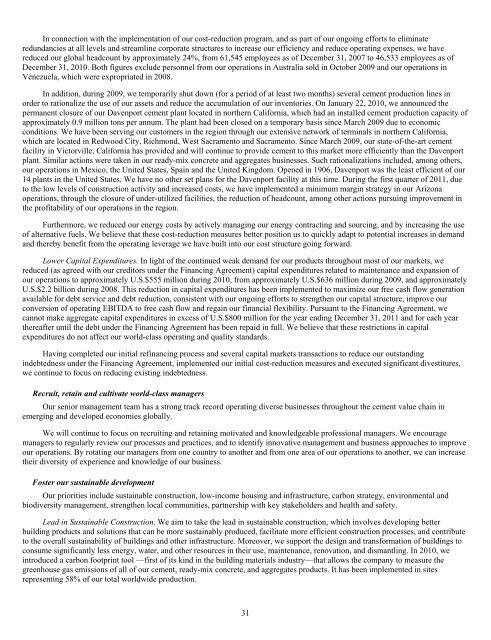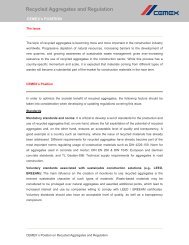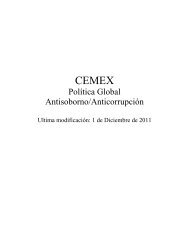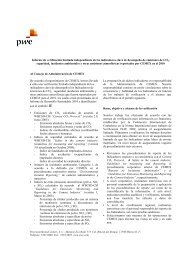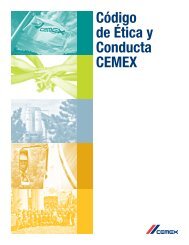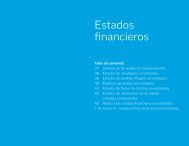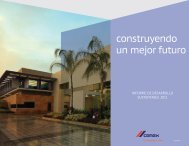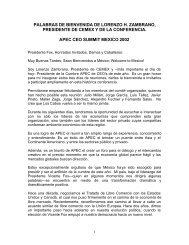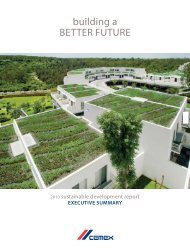building a STRONGER foundation - Cemex
building a STRONGER foundation - Cemex
building a STRONGER foundation - Cemex
Create successful ePaper yourself
Turn your PDF publications into a flip-book with our unique Google optimized e-Paper software.
In connection with the implementation of our cost-reduction program, and as part of our ongoing efforts to eliminate<br />
redundancies at all levels and streamline corporate structures to increase our efficiency and reduce operating expenses, we have<br />
reduced our global headcount by approximately 24%, from 61,545 employees as of December 31, 2007 to 46,533 employees as of<br />
December 31, 2010. Both figures exclude personnel from our operations in Australia sold in October 2009 and our operations in<br />
Venezuela, which were expropriated in 2008.<br />
In addition, during 2009, we temporarily shut down (for a period of at least two months) several cement production lines in<br />
order to rationalize the use of our assets and reduce the accumulation of our inventories. On January 22, 2010, we announced the<br />
permanent closure of our Davenport cement plant located in northern California, which had an installed cement production capacity of<br />
approximately 0.9 million tons per annum. The plant had been closed on a temporary basis since March 2009 due to economic<br />
conditions. We have been serving our customers in the region through our extensive network of terminals in northern California,<br />
which are located in Redwood City, Richmond, West Sacramento and Sacramento. Since March 2009, our state-of-the-art cement<br />
facility in Victorville, California has provided and will continue to provide cement to this market more efficiently than the Davenport<br />
plant. Similar actions were taken in our ready-mix concrete and aggregates businesses. Such rationalizations included, among others,<br />
our operations in Mexico, the United States, Spain and the United Kingdom. Opened in 1906, Davenport was the least efficient of our<br />
14 plants in the United States. We have no other set plans for the Davenport facility at this time. During the first quarter of 2011, due<br />
to the low levels of construction activity and increased costs, we have implemented a minimum margin strategy in our Arizona<br />
operations, through the closure of under-utilized facilities, the reduction of headcount, among other actions pursuing improvement in<br />
the profitability of our operations in the region.<br />
Furthermore, we reduced our energy costs by actively managing our energy contracting and sourcing, and by increasing the use<br />
of alternative fuels. We believe that these cost-reduction measures better position us to quickly adapt to potential increases in demand<br />
and thereby benefit from the operating leverage we have built into our cost structure going forward.<br />
Lower Capital Expenditures. In light of the continued weak demand for our products throughout most of our markets, we<br />
reduced (as agreed with our creditors under the Financing Agreement) capital expenditures related to maintenance and expansion of<br />
our operations to approximately U.S.$555 million during 2010, from approximately U.S.$636 million during 2009, and approximately<br />
U.S.$2.2 billion during 2008. This reduction in capital expenditures has been implemented to maximize our free cash flow generation<br />
available for debt service and debt reduction, consistent with our ongoing efforts to strengthen our capital structure, improve our<br />
conversion of operating EBITDA to free cash flow and regain our financial flexibility. Pursuant to the Financing Agreement, we<br />
cannot make aggregate capital expenditures in excess of U.S.$800 million for the year ending December 31, 2011 and for each year<br />
thereafter until the debt under the Financing Agreement has been repaid in full. We believe that these restrictions in capital<br />
expenditures do not affect our world-class operating and quality standards.<br />
Having completed our initial refinancing process and several capital markets transactions to reduce our outstanding<br />
indebtedness under the Financing Agreement, implemented our initial cost-reduction measures and executed significant divestitures,<br />
we continue to focus on reducing existing indebtedness.<br />
Recruit, retain and cultivate world-class managers<br />
Our senior management team has a strong track record operating diverse businesses throughout the cement value chain in<br />
emerging and developed economies globally.<br />
We will continue to focus on recruiting and retaining motivated and knowledgeable professional managers. We encourage<br />
managers to regularly review our processes and practices, and to identify innovative management and business approaches to improve<br />
our operations. By rotating our managers from one country to another and from one area of our operations to another, we can increase<br />
their diversity of experience and knowledge of our business.<br />
Foster our sustainable development<br />
Our priorities include sustainable construction, low-income housing and infrastructure, carbon strategy, environmental and<br />
biodiversity management, strengthen local communities, partnership with key stakeholders and health and safety.<br />
Lead in Sustainable Construction. We aim to take the lead in sustainable construction, which involves developing better<br />
<strong>building</strong> products and solutions that can be more sustainably produced, facilitate more efficient construction processes, and contribute<br />
to the overall sustainability of <strong>building</strong>s and other infrastructure. Moreover, we support the design and transformation of <strong>building</strong>s to<br />
consume significantly less energy, water, and other resources in their use, maintenance, renovation, and dismantling. In 2010, we<br />
introduced a carbon footprint tool —first of its kind in the <strong>building</strong> materials industry—that allows the company to measure the<br />
greenhouse gas emissions of all of our cement, ready-mix concrete, and aggregates products. It has been implemented in sites<br />
representing 58% of our total worldwide production.<br />
31


